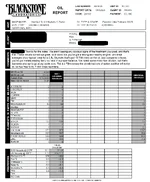BTW my plug about K&N filters / CAI's is primarily due to wear and maintenance. So you get 5 maybe 10 HP on a high power engine from a K&N filter + CAI yet you allow 12x the dust contamination into the combustion chamber...so how much power are you going to loose after 50k miles or 100k miles due to compression loss because there is a direct correlation to piston ring wear vs. particulate concentration?
I"d rather make a few HP less now but make the same power later on. Also K&N's dust capacity is MUCH lower than a paper filter. So they need frequent cleaning and their clogging curve is very exponential (meaning once they fill up they become very retrictive very rapidly). Typically they have only 1/2 to 1/3 of the dust capacity, so instead of 30k intervals for replacement, you should clean a K&N every 10k~15k miles or so to keep it flowing well, otherwise it will flow LESS than a paper filter.
Ever wonder why OE's, even makers of high horsepower track cars (GT350 with the 5.2L Voodoo engine uses a paper conical filter and CAI air box, not a K&N cloth / oil filter) that are street legal typically still use paper filters? The trade-off in long term reliablity and maintenance just isn't worth it for even performance street cars.
Lastly oiled cotton is risky for getting oil on the MAF when you have to clean an re-oil it, which will really mess up engine performance, then you have to remove the MAF and clean it to get proper air flow readings...just not worth the hastle / risks unless it's a track car that only sees a few thousand miles a year under race conditions.
They have a place, but in my opinion there are far better ways to get more power on street cars that operate under very diverse environmental conditions (temperature, altitude, humidity and fuel octane variations, highly loaded vehicle conditions etc.) over decades unlike a dedicated track car (which is where a dyno tune may be appropriate as a track car does not need to run a varying altitudes / humidity and temp changes, varying fuel quality, maintenance variations, cargo variations). That's why modern ECU maps are very complex with thousands of values in the data tables the ECU uses to determine optimal air flow, fuel and timing for a given load condition at a given altitude, humidity level, temperature and fuel octane. Phew, hopefully I've convinced any Mazda owners on there to seek more reliable and long term solutions to increase power train performance via maintenance and more well proven / researched technologies.
Benefits of Hydrogenated DLC Coatings:
1. The coating is what is wearing away, not the surface of the rubbing pairs (aka the bearing surfaces).
2. DLC Coatings have proven to support higher film strength during hydrodynamic lubrication regimes. In essence it allows better adhesion of the oil molecules to the bearing surfaces when the hydrodnamic wedge forms at speed, thus supporting increased load capability.
3. DLC coatings reach super lubricity levels while also reducing wear rates. Zinc or ZDDP is an anti-wear additive, but it does very little to reduction friction losses. Friction and wear are some times, but not always mutually exclusive. Low friction does NOT mean low wear or visa versa. Since hydrogenated DLC coatings are already water bonded, they don't have moisture absorption issues like MOS2, which is why it never found wide spread use in motor oils to reduce friction despite it's excellent low friction properties. In fact when it absorbs moisture, MOS2 becomes abrasive and increases wear! It is used heavily in sealed assemblies like CV axle joints or differentials etc. however because those can be sealed off from moisture exposure.
4. Hydrogenated DLC coatings last significantly longer when used with MoDTC, a newer organic molybdenum compound that is far less toxic and prone to water absorption than MOS2, but provides similar lubricity. MoDTC is used in most modern motor oil formulas to enhanced fuel economy (and very slight increase in power output).
5. They are non-toxic, so any exposure to living organisms, in particular aquatic ones, has no significant side effects.
6. Enhanced fuel economy, when your cruising at a steady speed, due to reaching super lubricity levels, less fuel is required to move the vehicle the same distance. This is mostly beneficial on flat or down hill grades. When going uphill, most of your fuel consumpion is due to moving the mass vertically. So if you do a lot of up-hill diriving you probably will only notice the increased torque output and responsiveness, not fuel economy. But if you do a decent amount of highway driving, you will see small gains.

